211 keeps county residents connected to social services

Key Takeaways
Anywhere from 1,000 to 1,500 calls come in each day from the public to 211 San Diego, a call center that helps connect people to housing, food, transportation and other social services.
“It’s not just a phone number,” said John Ohanian, president and CEO of 211 San Diego, who has worked for the center the past 11 years. “We’re assessing their risk and vulnerability — whether it’s food insecurity or housing or any of these things that basically allow people to live life.”
Last year, across the country, more than 13 million calls were made to 211. The toll-free call connects people to community resource specialists who can help callers find local services and resources. In many states, dialing 211 provides people in need with a shortcut through what can be a confusing network of health and human service agency phone numbers. By just dialing 211, those in need of assistance can be referred, and sometimes connected, to appropriate agencies and community organizations.
The service is available to 94 percent of the U.S. population, according to the Federal Communications Commission (FCC).
Eighteen years ago, United Way and other non-profits lobbied the FCC to make 211 a dedicated number for people in need. United Way of Greater Atlanta was the first organization to make information and referral services accessible using 211. Today, United Way operates or provides funding for more than 70 percent of 211 centers.
Joshua Pedersen, 211 director of United Way Worldwide, said that another primary funder of 211 centers is local government. “Each 211 is managed independently — it’s very community-based, bottom up,” he said. “There isn’t a 211 in every county, so they might be region-based.”
For county officials who are uncertain about the benefits of helping support a 211 center in their community, “there’s obviously a cost savings, because people are getting resources before it gets worse,” Pedersen said. “My advice to a county would be to make an investment in the community and pool your resources with a local United Way. That creates a level of sustainability for both.” If there isn’t a United Way in your county, you can contact the nearest one, he noted.
In San Diego, about one-third of the 211 San Diego’s annual $13 million budget comes from San Diego County. The center also has federal and state contracts, and also depends on grants and fundraising to round out its budget, Ohanian said.
The call center, which is open 24 hours a day, seven days a week, features about 140 full-time employees and offers translation services in up to 200 languages.
It also has a department that helps callers enroll in benefits. “We don’t make callers eligible for services, but we help them prepare applications,” said Ohanian.
Volunteers are brought in to handle even more calls that come in during emergencies such as wildfires. The center also hires veterans and former military to help transition active military personnel and “all the issues that come with that,” Ohanian said. The center also hears from the public via email, texting and online chat.
Learn More
In San Diego, they look for different people with varied backgrounds and expertise when hiring. “They need to know how social services work,” Ohanian said. New employees are put through several weeks of training before answering calls.
How do people find out about the 211 service? Many times, “depending on their situation, the agency they’re working with says ‘You know what? We don’t do that here but call 211,” Ohanian said.
What do most people call about? According to United Way, across the country, the main issues that most people called about in 2017 included:
- Housing or utilities assistance
- Physical or mental health services
- Help finding and obtaining employment,
- Services to address and prevent homelessness.
By calling 211, people might also get information about food and nutrition supplement programs, emergency information and disaster relief, services for veterans, health care, vaccination and health epidemic information, addiction prevention and rehabilitation programs, reentry help for ex-offenders, or a safe and confidential path out of physical or emotional domestic abuse.
At 211 San Diego, Ohanian said that awareness of 211 goes way up during disasters.
Pedersen, with 211 United Way Worldwide, said that is becoming more of a trend for 211 centers. “We’re seeing more and more the use of 211 during and after a disaster,” he said. “911 plays a crisis role of course, but a day or two later, people are asking ‘Where is the food drop? What about FEMA? Disaster food stamps? The foodbank? The cleanup process?’”
Ohanian noted that the 211 center in San Diego is “in a unique position to see emergency needs and trends in our community.” One of the trends, he said, includes doing as much as possible virtually to speed up help to residents. “We do telephonic signatures, virtual consent — so a lot of that can happen over the phone,” he said.
The center also follows up on high-risk clients and keeps their information, with their permission, so the center can monitor them to see how they’re doing. “When we make referrals to agencies, they can report back to let us know if they have been served,” he said.
The community information exchange makes the service “more person-centered,” he said, so that the center can better coordinate service delivery among agencies. “There’s a central record so we’re not duplicating efforts,” he said. About 50 non-profits are sharing about 65,000 client records.
One 211 call center for 16 counties
In Knoxville, Tenn., a 211 center anchored within the city’s 311 service center covers a 16-county region. The 311 center takes calls for things like fixing potholes on city streets. Russ Jensen, currently the director of 311 for the City of Knoxville, had worked with 211 service in the past, when he created the second 211 service in the country back in the late 90s “when east Tennessee went live,” he said.
Now he and his staff juggle both 311 and 211 calls under the same roof. “We’re unique in that 211 is located in my 311 center,” Jensen said. “About four years ago, United Way came to me and said ‘Would you guys consider moving 211 into your call center?’ He knew I’d had experience with 211 before. We brought it inhouse in 2015.”
The 211 center “works with the Community Action Committee and their Office on Aging, which is a city/county agency,” he said. The funds for 211 are allocated from United Way of Greater Knoxville and other county United Way affiliates.
“It is ridiculously cost effective,” he said. “All of the 311 employees are cross-trained [on both 211 and 311 calls]. Our cost per call on a 211 call is in the $3.50 per call range. Most call centers are three and four times that.”
The center employs seven people who answer about 1,000 calls a day (from 7 a.m. to 5 p.m.) with most being city 311 calls; but about 60 to 100 of those calls are 211 calls from residents in the surrounding 16-county region, Jensen said.
Housing, food and utilities make up the bulk of the 211 calls, Jensen said. “In our area, the majority are people needing help with rent.”
The center has access to about 1,500 different agencies, most of which are non-profits. “And that’s where most calls are sent,” he said. Asked whether they know if they are helping folks or not, Jensen admits that “we struggle with that.”
“We are strictly I&R (information and referral) and not casework,” he said. “Aside from sheer volume, it’s hard to say. The way we look at the data, in this case, the more the data goes up, the better. If we’re getting people to call I&R on the front end, they’re less likely to end up in crisis mode.”
The center keeps in close contact with case workers. “They’ll call us up and say ‘Hey, here’s everything I’ve done, I’m all out of resources, what else have you got?’ That’s the way it’s supposed to work.”
Public transportation for medical appointments
The Knoxville 211 center is piloting a one-year “Rides to Wellness” program using a $250,000 grant from the Knox Area Transit. Working with Cherokee Health, a “travel trainer,” housed in the call center who is also legally blind and an avid bus rider, helps train new riders, those who rely on public transportation for medical appointments, Jensen said.
The grant application for the pilot project was successful because they pointed out that the potential riders weren’t the problem, it was the doctors, he noted. “We have focused as much time training our health care providers as our riders. It’s not the people who ride the bus that are an issue, it’s the doctors. The patients are afraid they’re not going to make their appointment on time. We’ve educated the doctors as much as the patients.”
Getting the word out about 211 is important, Jensen said. One way they’re doing that? Hosting a legislative breakfast with their healthcare partners for county and state officials to kick off a yearlong information rollout about 211.
“We’re saying, ‘Here’s 211, here are the benefits,” he said. “People need to be using it.’”
The Other ‘1-1s’
In addition to 211 service and the more widely known 911 service, there are other “1-1s.” Here’s a look:
311: Non-emergency 311 call systems, used increasingly by local governments, offer a number of advantages. They give residents a quick, convenient way to call in about problems in their neighborhoods, and get a response. They enable local governments to identify patterns and address issues proactively.
411: In addition to the local and long-distance directory services, there is also consumer-choice and privacy-protected “Wireless 411 Service.” As specified by the industry, the service will give consumers the choice of including their wireless phone numbers in voice 411.
511: In July 2000, the Federal Communications Commission assigned this number as a nationwide phone number for intelligent transportation system traveler information. Its use is being promoted by the Department of Transportation. Most 511 travel information services are tied into local and state information.
611: This number is for contacting your phone carrier’s customer service.
711: The Federal Communications Commission adopted use of the 711 dialing code for access to Telecommunications Relay Services (TRS). TRS permits persons with a hearing or speech disability to use the telephone system via a text telephone (TTY) or other device to call persons with or without such disabilities.
811: Call 811 from anywhere in the country a few days prior to digging to protect yourself and others from unintentionally hitting underground utility lines and your call will automatically be routed to your local one call center.
911: This number is for emergencies. The Wireless Communications and Public Safety Act took effect Oct. 26, 1999. The purpose of the act is to improve public safety by encouraging and facilitating the prompt deployment of a nationwide communications infrastructure for emergency services. State and local authorities continue to expand 911 coverage and upgrade 911 services. Although there may be some counties that still do not have basic 911 services, wireless carriers can deliver 911 calls to the appropriate local emergency authority.

Attachments
Related News

County Countdown – Dec. 15, 2025
Every other week, NACo's County Countdown reviews top federal policy advocacy items with an eye towards counties and the intergovernmental partnership.
Stretching small opioid settlement allocations helps funding do more
States and localities are set to receive $56 billion in opioid settlement dollars over an 18-year period, but not every county that receives settlement funding will get enough to build out infrastructure.

